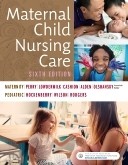Test Bank for Maternal Child Nursing Care 6th Edition by Perry
$35.00 Original price was: $35.00.$26.50Current price is: $26.50.
Test Bank for Maternal Child Nursing Care 6th Edition by Perry
Instant download Test Bank for Maternal Child Nursing Care 6th Edition by Perry pdf docx epub after payment.

Chapter 02: The Family, Culture, Spirituality, and Home Care
Perry: Maternal Child Nursing Care, 6th Edition
MULTIPLE CHOICE
1. A married couple lives in a single-family house with their newborn son and the husband’s daughter from a previous marriage. On
the basis of the information given, what family form best describes this family?
a. Married-blended family
b. Extended family
c. Nuclear family
d. Same-sex family
ANS: A
Married-blended families are formed as the result of divorce and remarriage. Unrelated family members join together to create a
new household. Members of an extended family are kin, or family members related by blood, such as grandparents, aunts, and
uncles. A nuclear family is a traditional family with male and female partners and the children resulting from that union. A
same-sex family is a family with homosexual partners who cohabit with or without children.
PTS: 1 DIF: Cognitive Level: Knowledge
OBJ: Nursing Process: Assessment MSC: Client Needs: Psychosocial Integrity
2. In what form do families tend to be most socially vulnerable?
a. Married-blended family
b. Extended family
c. Nuclear family
d. Single-parent family
ANS: D
The single-parent family tends to be vulnerable economically and socially, creating an unstable and deprived environment for the
growth potential of children. The married-blended family, the extended family, and the nuclear family are not the most socially
vulnerable.
PTS: 1 DIF: Cognitive Level: Knowledge OBJ: Nursing Process: Planning
MSC: Client Needs: Psychosocial Integrity
3. The nurse should be aware that the criteria used to make decisions and solve problems within families are based primarily on
family:
a. rituals and customs.
b. values and beliefs.
c. boundaries and channels.
d. socialization processes.
ANS: B
Values and beliefs are the most prevalent factors in the decision-making and problem-solving techniques of families. Although
culture may play a part in the decision-making process of a family, ultimately values and beliefs dictate the course of action taken
by family members. Boundaries and channels affect the relationship between the family members and the health care team, not the
decisions within the family. Socialization processes may help families with interactions with the community, but they are not the
criteria used for decision making within the family.
PTS: 1 DIF: Cognitive Level: Comprehension OBJ: Nursing Process: Planning
MSC: Client Needs: Psychosocial Integrity
4. Using the family stress theory as an intervention approach for working with families experiencing parenting, the nurse can help the
family change internal context factors. These include:
a. Biologic and genetic makeup.
b. Maturation of family members.
c. The family’s perception of the event.
d. The prevailing cultural beliefs of society.
ANS: C
The family stress theory is concerned with the family’s reaction to stressful events; internal context factors include elements that a
family can control such as psychologic defenses. It is not concerned with biologic and genetic makeup, maturation of family
members, or the prevailing cultural beliefs of society.
PTS: 1 DIF: Cognitive Level: Comprehension OBJ: Nursing Process: Diagnosis
MSC: Client Needs: Psychosocial Integrity
5. While working in the prenatal clinic, you care for a very diverse group of patients. When planning interventions for these families,
you realize that acceptance of the interventions will be most influenced by:
a. educational achievement.
b. income level.
c. subcultural group.
d. individual beliefs.
ANS: D
The patient’s beliefs are ultimately the key to acceptance of health care interventions. However, these beliefs may be influenced by
factors such as educational level, income level, and ethnic background. Educational achievement, income level, and subcultural
group all are important factors. However, the nurse must understand that a woman’s concerns from her own point of view will have
the most influence on her compliance.
PTS: 1 DIF: Cognitive Level: Application OBJ: Nursing Process: Planning
MSC: Client Needs: Psychosocial Integrity
Copyright © 2018, Elsevier Inc. All Rights Reserved. 2
6. The nurse’s care of a Hispanic family includes teaching about infant care. When developing a plan of care, the nurse bases
interventions on the knowledge that in traditional Hispanic families:
a. breastfeeding is encouraged immediately after birth.
b. male infants typically are circumcised.
c. the maternal grandmother participates in the care of the mother and her infant.
d. special herbs mixed in water are used to stimulate the passage of meconium.
ANS: C
In Hispanic families, the expectant mother is influenced strongly by her mother or mother-in-law. Breastfeeding often is delayed
until the third postpartum day. Hispanic male infants usually are not circumcised. Olive or castor oil may be given to stimulate the
passage of meconium.
PTS: 1 DIF: Cognitive Level: Application OBJ: Nursing Process: Planning
MSC: Client Needs: Psychosocial Integrity
7. The woman’s family members are present when the home care maternal-child nurse arrives for a after birth and newborn visit.
What should the nurse do?
a. Observe the family members’ interactions with the newborn and one another.
b. Ask the woman to meet with her and the baby alone.
c. Do a brief assessment on all family members present.
d. Reschedule the visit for another time so that the mother and infant can be assessed
privately.
ANS: A
The nurse should introduce herself to the patient and the other family members present. Family members in the home may be
providing care and assistance to the mother and infant. However, this care may not be based on sound health practices. Nurses
should take the opportunity to dispel myths while family members are present. The responsibility of the home care maternal-child
nurse is to provide care to the new after birth mother and her infant, not to all family members. The nurse can politely ask about the
other people in the home and their relationships with the woman. Unless an indication is given that the woman would prefer
privacy, the visit may continue.
PTS: 1 DIF: Cognitive Level: Analysis
OBJ: Nursing Process: Assessment MSC: Client Needs: Psychosocial Integrity
8. The nurse should be aware that during the childbearing experience an African-American woman is most likely to:
a. seek prenatal care early in her pregnancy.
b. avoid self-treatment of pregnancy-related discomfort.
c. request liver in the after birth period to prevent anemia.
d. arrive at the hospital in advanced labor.
ANS: D
African-American women often arrive at the hospital in far-advanced labor. These women may view pregnancy as a state of
wellness, which is often the reason for delay in seeking prenatal care. African-American women practice many self-treatment
options for various discomforts of pregnancy, and they may request liver in the after birth period, but this is based on a belief that
the liver has a high blood content.
PTS: 1 DIF: Cognitive Level: Comprehension
OBJ: Nursing Process: Assessment MSC: Client Needs: Health Promotion and Maintenance
9. To provide competent care to an Asian-American family, the nurse should include which of the following questions during the
assessment interview?
a. “Do you prefer hot or cold beverages?”
b. “Do you want milk to drink?”
c. “Do you want music playing while you are in labor?”
d. “Do you have a name selected for the baby?”
ANS: A
Asian-Americans often prefer warm beverages. Milk usually is excluded from the diet of this population. Asian-American women
typically labor in a quiet atmosphere. Delaying naming the child is common for Asian-American families.
PTS: 1 DIF: Cognitive Level: Application
OBJ: Nursing Process: Assessment MSC: Client Needs: Physiologic Integrity
10. The patient’s family is important to the maternity nurse because:
a. they pay the bills.
b. the nurse will know which family member to avoid.
c. the nurse will know which mothers will really care for their children.
d. the family culture and structure will influence nursing care decisions.
ANS: D
Family structure and culture influence the health decisions of mothers.
PTS: 1 DIF: Cognitive Level: Comprehension OBJ: Nursing Process: Planning
MSC: Client Needs: Psychosocial Integrity
Copyright © 2018, Elsevier Inc. All Rights Reserved. 3
11. A mother’s household consists of her husband, his mother, and another child. She is living in a(n):
a. extended family.
b. single-parent family.
c. married-blended family.
d. nuclear family.
ANS: A
An extended family includes blood relatives living with the nuclear family. Both parents and a grandparent are living in this
extended family. Single-parent families comprise an unmarried biologic or adoptive parent who may or may not be living with
other adults. Married-blended refers to families reconstructed after divorce. A nuclear family is where male and female partners and
their children live as an independent unit.
PTS: 1 DIF: Cognitive Level: Application
OBJ: Nursing Process: Assessment MSC: Client Needs: Psychosocial Integrity
12. A traditional family structure in which male and female partners and their children live as an independent unit is known as a(n):
a. extended family.
b. binuclear family.
c. nuclear family.
d. blended family.
ANS: C
About two thirds of U.S. households meet the definition of a nuclear family. Extended families include additional blood relatives
other than the parents. A binuclear family involves two households. A blended family is reconstructed after divorce and involves
the merger of two families.
PTS: 1 DIF: Cognitive Level: Knowledge
OBJ: Nursing Process: Assessment MSC: Client Needs: Psychosocial Integrity
13. Which statement about family systems theory is inaccurate?
a. A family system is part of a larger suprasystem.
b. A family as a whole is equal to the sum of the individual members.
c. A change in one family member affects all family members.
d. The family is able to create a balance between change and stability.
ANS: B
A family as a whole is greater than the sum of its parts. The other statements are characteristics of a system that states that a family
is greater than the sum of its parts.
PTS: 1 DIF: Cognitive Level: Comprehension
OBJ: Nursing Process: Assessment MSC: Client Needs: Psychosocial Integrity
14. A pictorial tool that can assist the nurse in assessing aspects of family life related to health care is the:
a. genogram.
b. family values construct.
c. life cycle model.
d. human development wheel.
ANS: A
A genogram depicts the relationships of family members over generations.
PTS: 1 DIF: Cognitive Level: Knowledge
OBJ: Nursing Process: Assessment MSC: Client Needs: Psychosocial Integrity
15. The process by which people retain some of their own culture while adopting the practices of the dominant society is known as:
a. acculturation.
b. assimilation.
c. ethnocentrism.
d. cultural relativism.
ANS: A
Acculturation is the process by which people retain some of their own culture while adopting the practices of the dominant society.
This process takes place over the course of generations. Assimilation is a loss of cultural identity. Ethnocentrism is the belief in the
superiority of one’s own culture over the cultures of others. Cultural relativism recognizes the roles of different cultures.
PTS: 1 DIF: Cognitive Level: Knowledge OBJ: Nursing Process: Planning
MSC: Client Needs: Psychosocial Integrity
16. When attempting to communicate with a patient who speaks a different language, the nurse should:
a. respond promptly and positively to project authority.
b. never use a family member as an interpreter.
c. talk to the interpreter to avoid confusing the patient.
d. provide as much privacy as possible.
ANS: D
Providing privacy creates an atmosphere of respect and puts the patient at ease. The nurse should not rush to judgment and should
make sure that he or she understands the patient’s message clearly. In crisis situations, the nurse may need to use a family member
or neighbor as a translator. The nurse should talk directly to the patient to create an atmosphere of respect.
PTS: 1 DIF: Cognitive Level: Application
OBJ: Nursing Process: Implementation MSC: Client Needs: Psychosocial Integrity
Copyright © 2018, Elsevier Inc. All Rights Reserved. 4
17. In which culture is the father more likely to be expected to participate in the labor and delivery?
a. Asian-American
b. African-American
c. European-American
d. Hispanic
ANS: C
European-Americans expect the father to take a more active role in the labor and delivery than the other cultures.
PTS: 1 DIF: Cognitive Level: Comprehension
OBJ: Nursing Process: Implementation MSC: Client Needs: Psychosocial Integrity
18. Which statement about cultural competence is not accurate?
a. Local health care workers and community advocates can help extend health care
to underserved populations.
b. Nursing care is delivered in the context of the patient’s culture but not in the
context of the nurse’s culture.
c. Nurses must develop an awareness of and sensitivity to various cultures.
d. A culture’s economic, religious, and political structures influence practices that
affect childbearing.
ANS: B
The cultural context of the nurse also affects nursing care. The work of local health care workers and community advocates is part
of cultural competence; the nurse’s cultural context is also important. Developing sensitivity to various cultures is part of cultural
competence, but the nurse’s cultural context is also important. The impact of economic, religious, and political structures is part of
cultural competence; the nurse’s cultural context is also important.
PTS: 1 DIF: Cognitive Level: Comprehension OBJ: Nursing Process: Planning
MSC: Client Needs: Psychosocial Integrity
MATCHING
You are getting ready to participate in discharge teaching with a non–English-speaking new mother. The interpreter has arrived in
the patient care unit to assist you in providing culturally competent care. In the correct order, from 1 through 6, number the steps
that you would take to work with the interpreter.
a. Introduce yourself to the interpreter and converse informally.
b. Outline your statements and questions, listing the key pieces of information you
need to know.
c. Make sure the interpreter is comfortable with technical terms.
d. Learn something about the culture of the patient.
e. Make notes on what you learned for future reference.
f. Stop every now and then and ask the interpreter “How is it going?”
1. Step One
2. Step Two
3. Step Three
4. Step Four
5. Step Five
6. Step Six
1. ANS: B PTS: 1 DIF: Cognitive Level: Application
OBJ: Nursing Process: Implementation MSC: Client Needs: Health Promotion and Maintenance
NOT: To work successfully with an interpreter, the nurse must organize her teaching into four categories. These include actions that are
necessary before the interview, meeting with the interpreter, during the interview, and after the interview. The nurse must be sensitive to
cultural and situational differences (e.g., a woman from the Middle East may not wish to have a male interpreter present).
2. ANS: D PTS: 1 DIF: Cognitive Level: Application
OBJ: Nursing Process: Implementation MSC: Client Needs: Health Promotion and Maintenance
NOT: To work successfully with an interpreter, the nurse must organize her teaching into four categories. These include actions that are
necessary before the interview, meeting with the interpreter, during the interview, and after the interview. The nurse must be sensitive to
cultural and situational differences (e.g., a woman from the Middle East may not wish to have a male interpreter present).
3. ANS: A PTS: 1 DIF: Cognitive Level: Application
OBJ: Nursing Process: Implementation MSC: Client Needs: Health Promotion and Maintenance
NOT: To work successfully with an interpreter, the nurse must organize her teaching into four categories. These include actions that are
necessary before the interview, meeting with the interpreter, during the interview, and after the interview. The nurse must be sensitive to
cultural and situational differences (e.g., a woman from the Middle East may not wish to have a male interpreter present).
4. ANS: C PTS: 1 DIF: Cognitive Level: Application
OBJ: Nursing Process: Implementation MSC: Client Needs: Health Promotion and Maintenance
NOT: To work successfully with an interpreter, the nurse must organize her teaching into four categories. These include actions that are
necessary before the interview, meeting with the interpreter, during the interview, and after the interview. The nurse must be sensitive to
cultural and situational differences (e.g., a woman from the Middle East may not wish to have a male interpreter present).
5. ANS: F PTS: 1 DIF: Cognitive Level: Application
OBJ: Nursing Process: Implementation MSC: Client Needs: Health Promotion and Maintenance
NOT: To work successfully with an interpreter, the nurse must organize her teaching into four categories. These include actions that are
necessary before the interview, meeting with the interpreter, during the interview, and after the interview. The nurse must be sensitive to
cultural and situational differences (e.g., a woman from the Middle East may not wish to have a male interpreter present).
6. ANS: E PTS: 1 DIF: Cognitive Level: Application
OBJ: Nursing Process: Implementation MSC: Client Needs: Health Promotion and Maintenance
NOT: To work successfully with an interpreter, the nurse must organize her teaching into four categories. These include actions that are
necessary before the interview, meeting with the interpreter, during the interview, and after the interview. The nurse must be sensitive to
cultural and situational differences (e.g., a woman from the Middle East may not wish to have a male interpreter present).
Related products
Test Bank
Test Bank for Decision Support and Business Intelligence Systems, 9th Edition: Efraim Turban
Test Bank
Test Bank for Clinical Immunology and Serology A Laboratory Perspective, 3rd Edition: Stevens











